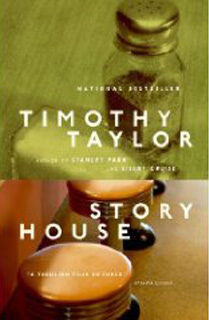
In his first novel, Stanley Park, Taylor brought readers into the inner workings of the Vancouver culinary scene, writing evocatively about everything from divine local ingredients to kitchen politics. In Story House, he takes on the rarefied world of architectural design – with some boxing, fishing and reality TV thrown in.
Graham and Elliot Gordon are half-brothers, six months apart, the only sons of Packer Gordon, a famous architect. Graham is the natural son of Packer and his wife. Elliot is the product of Packer’s dalliance with a mistress. The boys are openly hostile towards each other, always have been, and when they reach their mid-teens, Packer decides they will settle their differences in a boxing ring. He takes them to Pogey Nealon, a retired fighter who runs a gym out of the basement of his house on Vancouver’s Downtown Eastside. There, after eight weeks of training, the brothers box three rounds that will change their lives forever, as their father watches it all from a distance far greater than ringside: through the lens of his Bolex camera.
Some twenty-odd years later, both Pogey and Packer are dead, and it comes to light that Pogey’s house – the scene of Graham and Elliot’s pivotal battle – was likely an early design of Packer Gordon. Now deserted, the boarded-up building is home only to decades-worth of Pogey’s papers and film reels, and a slow rot that eats away at the walls. Graham is an architect himself, gaining recognition not only for his last name but his own work; he’s recently separated from his wife Esther and at a loss for how to make things work. Elliot is an importer of counterfeit brand-name products who works out of an old hotel on Hastings, and is married to a beautiful woman named Deirdre who gave up architecture to raise their young twins. The brothers’ paths have only crossed twice in the intervening years, and for both, that was twice too many.
In spite of their differences, which have only been magnified over time, Graham and Elliot agree to cooperate in restoring the house at 55 Mary Street, with enthusiastic help from the producer of the hit reality TV showUnexpected Architecture. It’s a seemingly doomed venture, but will make for great television. And as the plans for preserving Packer Gordon’s legacy begin to come together, there’s not only a surprising amount of collaboration, but cautious optimism that they might just pull it off. Yet nobody is prepared for what actually takes place when the cameras roll.
CRITICAL PRAISE FOR STORY HOUSE:
“Cities reflect the souls of their inhabitants, and nothing lays claim to the soul of a city more than a novel that uses it as a character…. Timothy Taylor does it right…. [He] knows Vancouver’s arteries and bones. His portraits of that spectacular city … are as complex and well-rounded as a Tolstoy character.”
—Calgary Herald
“Taylor’s very good at conjuring vivid visuals, a talent played out in spades in the novel’s tragic final act. . . . Story House is a big, brainy novel. An ambitious project. . . . Taylor’s book [is] intelligently and solidly built.”
—The Globe and Mail
“Taylor has a knack for imbuing his stories with lyric realism, unearthing beauty in the mundane and trivial…. Story House is never less than eminently readable.”
—Winnipeg Free Press
“Taylor is a master of the dramatic in medas res and abrupt transition. . . .tour de force writing. . . . Taylor harrows the house of the dead in gripping fashion; he deserves all his accolades, and then some.”
—National Post
“Story House reveals all of Taylor’s hallmarks and strengths. No one writes about work with such attention to the minutiae. It’s not merely getting the facts; Taylor enters the language and customs of distinct societies and reveals them with astonishing verisimilitude. He immerses readers in alien worlds. . . . Story House is a thrilling tour de force, a most impressive achievement of idea and implementation, of structure in service of function. It’s architectural, really. And Timothy Taylor is one of very few writers who could have made it work so well.”
—Ottawa Citizen
